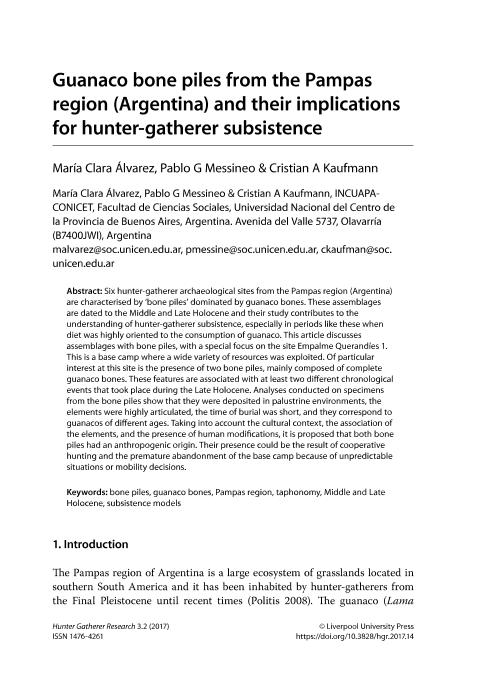Artículo
Guanaco bone piles from the Pampas region (Argentina) and their implications for hunter-gatherer subsistence
Fecha de publicación:
20/05/2018
Editorial:
Liverpool University Press
Revista:
Hunter Gatherer Research
ISSN:
2056-3264
Idioma:
Inglés
Tipo de recurso:
Artículo publicado
Clasificación temática:
Resumen
Six hunter-gatherer archaeological sites from the Pampas region (Argentina) are characterised by ?bone piles? dominated by guanaco bones. These assemblagesare dated to the Middle and Late Holocene and their study contributes to theunderstanding of hunter-gatherer subsistence, especially in periods like these when diet was highly oriented to the consumption of guanaco. This article discusses assemblages with bone piles, with a special focus on the site Empalme Querandíes 1. This is a base camp where a wide variety of resources was exploited. Of particular interest at this site is the presence of two bone piles, mainly composed of complete guanaco bones. These features are associated with at least two different chronological events that took place during the Late Holocene. Analyses conducted on specimens from the bone piles show that they were deposited in palustrine environments, the elements were highly articulated, the time of burial was short, and they correspond to guanacos of different ages. Taking into account the cultural context, the association of the elements, and the presence of human modifications, it is proposed that both bone piles had an anthropogenic origin. Their presence could be the result of cooperative hunting and the premature abandonment of the base camp because of unpredictable situations or mobility decisions.
Palabras clave:
Bone Piles
,
Guanaco Bones
,
Pampas Region
,
Taphonomy
Archivos asociados
Licencia
Identificadores
Colecciones
Articulos(INCUAPA)
Articulos de INVESTIGACIONES ARQUEOLOGICAS Y PALEONTOLOGICAS DEL CUATERNARIO PAMPEANO
Articulos de INVESTIGACIONES ARQUEOLOGICAS Y PALEONTOLOGICAS DEL CUATERNARIO PAMPEANO
Citación
Alvarez, María Clara; Messineo, Pablo Geronimo; Kaufmann, Cristian Ariel; Guanaco bone piles from the Pampas region (Argentina) and their implications for hunter-gatherer subsistence; Liverpool University Press; Hunter Gatherer Research; 3; 2; 20-5-2018; 289-321
Compartir
Altmétricas




